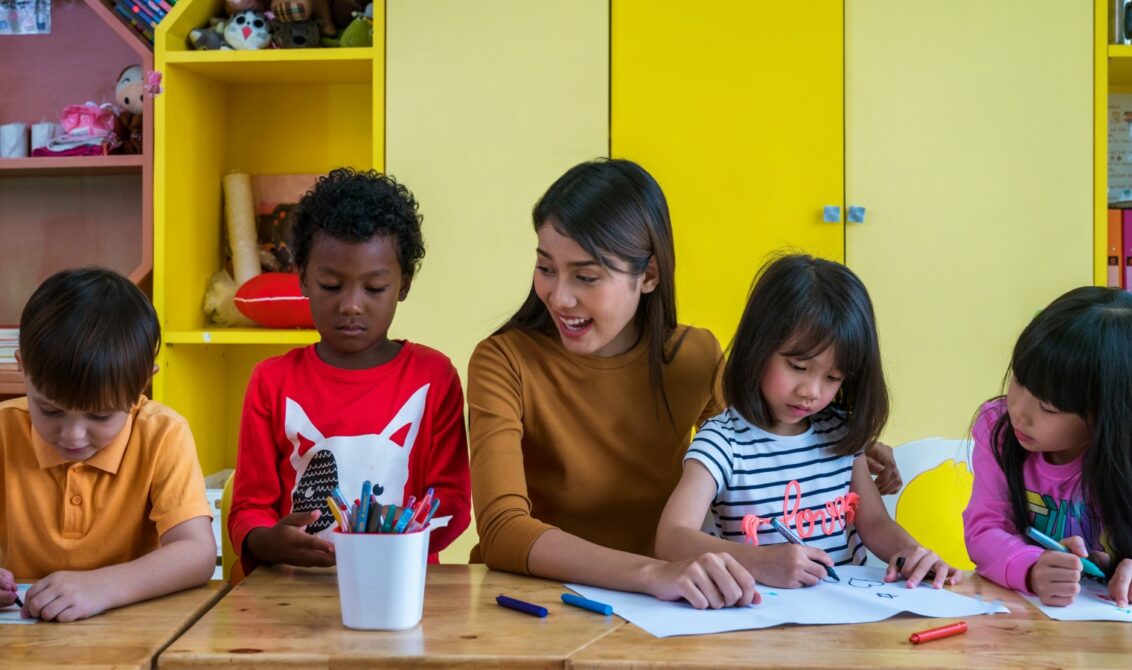
A teachers’ job is without a doubt to make learning happen. But every teacher knows that teaching something doesn’t mean students learn it. Teachers also know that students learn new knowledge or behaviours from experiences around them. In other words, learning happens because students observe and imitate modelled behaviours in their context. This view of learning is known as Bandura’s Social Learning Theory (SLT) and has a lot to offer to teachers. So let’s explore this perspective in more depth.
What is social learning theory in education?
Learning is complex so there are many different perspectives trying to understand and explain it, such as behaviourism and cognitivism. Both these theories highlight the role of the individual in the learning process. Bandura’s (1977) Social Learning Theory builds on behaviourist and cognitivist principles but emphasises that learning is a social activity. Learning happens in a social context through observations of and interaction with others. An example of the influence of SLT in education is the focus on creating collaborative learning environments. Here students work with others to build and develop their knowledge together.
At the core of SLT is modelling. Learning is a result of observing others’ models, behaviour, actions or language and imitating this. If the modelled behaviour shows positive outcomes or leads to rewards, it is more likely students will imitate it than behaviour leading to negative outcomes. But how can students benefit from social learning?
How can students benefit from social learning?
Modelling, demonstrating behaviours or activities in the classroom, is one of the most powerful instructional strategies (Allison & Tharby, 2015) and a key component for effective learning and teaching. There are many benefits of students actively observing teachers modelling:
- Children naturally learn by observing. Modelling appropriate behaviour can allow young learners to develop appropriate classroom behaviour.
- Seeing or hearing the teacher, or a more experienced classmate, model a task or cognitive strategy clarifies the end-product
- Modelling can help break the learning process into manageable steps which better enables students to become independent learners
- Modelling and actively observing can promote inclusion and well-being in the classroom.
How does the social learning theory work?
For learning from observation to be effective the following cognitive conditions need to be in place according to Bandura:
- Attention – learners need to attend to the modelled behaviour and its outcomes. Teachers need to focus learners’ attention on the model by selecting age-appropriate materials, tasks and modes of delivery.
- Retention – learners need to be able to encode and store the new behaviour in their long-term memory before they can recall it. Proactively plan to include techniques that facilitate retention. Make activities meaningful, use colour-coding and images.
- Reproduction – learners need to be provided with plenty of opportunities to practice the modelled behaviour to advance their learning. Allow time to imitate, practice the new behaviour and provide feedback. Make activities meaningful, varied, and include collaborative work.
- Motivation – learners need to be willing to imitate the modelled behaviour. Provide varied activities and the right level of challenge. Celebrate successes; show positive reinforcement and highlight intrinsic rewards when the modelled behaviour is imitated appropriately.
So, these are the principles of social learning theory. But how can you apply social learning theory? Below are five ways to integrate modelling in the classroom. Remember, what you model is based on your students’ learning needs.
How can we use social learning theory in our classroom?
1.Be a role model
Teacher behaviour is a powerful tool. Children notice how teachers respond to the environment. Our responses show our values, beliefs and ways of thinking. For example, if we fail to respond to bullying – a school safety concern – children observing us might think this behaviour is acceptable. Model qualities and values students need to succeed in learning and life, such as:
- Treating others with respect – stay calm and collected even if you feel like shouting
- Embracing mistakes – if we admit to making mistakes, students will be less worried about them too!
2. Meta-cognitive teacher modelling
Cognitive tasks such as reading, happen in our heads and are invisible. Using a thinking-aloud approach, talking through our thought processes, while answering a reading or exam question, can make thinking explicit for students. This kind of modelling – followed by repeated practice – allows students to self-regulate these tasks in future. Because they can now start applying the processes themselves.
- Use think-alouds to show how you found the right answer for example in a listening test
- Support your math think-aloud with realia, visuals or drawing to support the observation.
3. Multiple modelling to scaffold
Writing is a challenge for many students. Modelling writing can help students improve. First, get students to watch and listen to you modelling writing. Next, invite students’ ideas and practise writing the same genre together. Providing feedback and positive reinforcement here can strengthen their practice. Finally, students write in small groups or alone.
- You can record the first step, with your text and voice.
- Sharing your own doubts or challenges whilst live writing helps normalise these feelings for students.
4. Deepening modelling
To maintain students’ attention and engage them whilst modelling, ask questions. Asking questions also shows if students have any misconceptions about the task. Plan your questions in advance so they help focus on key points to get across.
- Ask varied questions: ‘What am I doing?’ (descriptive) ‘what do you think is next (predictive), ‘why am I doing this?’ (exploratory) etc.
- Ask questions about common misconceptions to check students’ understanding: ‘What is the result if we do/ use X here?’ or ‘is it a good idea to do/ use….?’
5. Peer modelling
Another social learning theory example is using peers to demonstrate tasks or activities. Not only is this a more student-centred way of modelling, it also allows students to observe equals who are successful. This can empower students who lack self-efficacy (Bandura, 1977) to develop confidence and start imitating the behaviour.
- Allow time in lessons for students to share examples of great work. Ask others to identify the successful aspects of the model.
- Pair/ group students and get a lead-learner to model the task or talk through a completed model.
As you can see, modelling and imitating are powerful tools for learning. But it also highlights the importance of modelling appropriate teacher behaviour in the classroom to avoid learners imitating non-desired behaviours and attitudes.
How have you applied social learning theory into your classroom and have you noticed a difference in behaviour?
References
Allisson, S. & Tharby, A. (2015) Making every lesson count. Six principles to support great teaching and learning. Crown House
Bandura, A. (1977) Social Learning Theory. New York: General Learning Press
Sign up to receive our blog updates
Like what you read and want to receive more articles like this direct to your inbox? Subscribe to our blog and we’ll send you a fortnightly digest of the blog posts you may have missed, plus links to free resources to support your teaching and learning.

